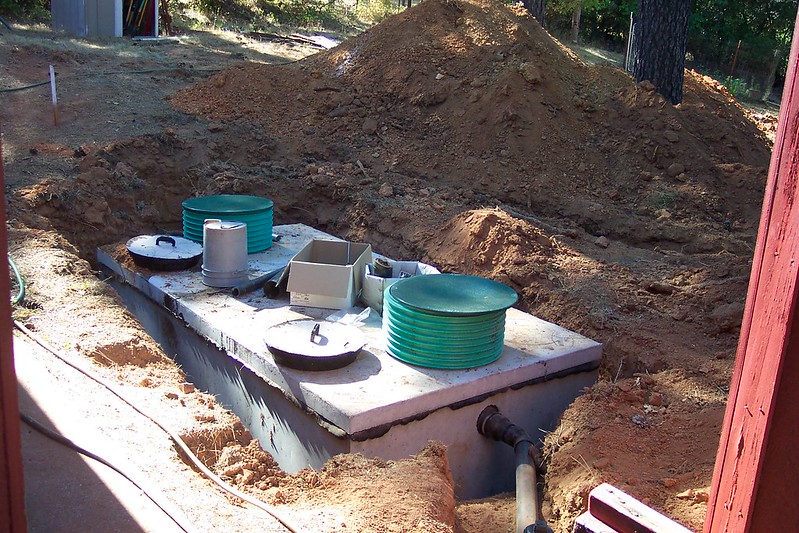If you’re building a house, a septic tank is obviously one of the most important things you should be thinking about.
Septic tanks handle wastewater outside your home. The size of the septic tank is one of the most crucial factors when it comes to whether it runs well or not.
In this guide, we’ll walk you through why septic tanks’ sizes matter and how to determine the right tank size for your home according to your needs.
Read on.
Why Septic Tanks’ Sizes Matter?
To understand why size matters here, we’ve to explain first what do septic tanks do.
Septic tanks are the first stop of septic systems. They’re where all the water in your house goes to first. No matter where that wastewater comes from; laundry, showers, toilets, or the kitchen.
There, liquids are separated from solids. After the breakage of solids, everything flows to the drainage system, which is the other part of the septic system.
What goes on down there is that the wastewater stays in the septic tanks until retention is done. Retentions happen through the bacteria in the tank. Bacteria break down the solids after they’re separated from the liquids.
Now, if the tank is too small. What happens is that the bacteria don’t get enough time to fully separate and break the solids. The waste is forced out into drainage before the bacteria is done breaking it down because more wastewater is coming in.
This will obviously lead to clogging in the drainage system and might cause huge issues.
However, if the tank is too big, there won’t be enough heat for bacteria formation. Not enough bacteria leads to not enough breakage of wastes. This would cause the same issues to happen.
Check here for tips on how to take the best care of your septic system.
How to Decide What Size Is Best?
Before we go on to discuss how big of a tank do you need, we have got an important note for you.
How to Calculate a Tank’s Capacity in Gallons?
If the tank is rectangular then Length x Width x Depth in feet x 7.5 = gallons
If the tank is round then 3.14 x radius squared x depth (all in feet) = cubic capacity.
Cubic capacity x 7.5 = gallons capacity.
There are several factors that affect how big the septic tank should be. Here they’re!
1. Water Usage
You can determine how big of a tank you need depending on your household’s water usage.
This is usually regarded as the most efficient factor you can decide by, as how big of a tank is needed is directly correlated with how much water it’ll handle.
Make sure you know the minimum tank size required in your part of the country. Those rules vary, but in most places, the minimum size allowed is 1000 gallons.
A rule of thumb is the tank should be at least 400 gallons bigger than the amount of water it’ll handle. For example, if your water usage per day is 500 gallons then the septic tank should be 900 gallons.
The average water usage of a person per day is 80-100 gallons, that’ll take us to our next factor.
2. Number of People Residing in the House
How big of a tank you need differs according to whether you live alone or if you live with 6+ family members. To calculate, use the rule above.
If 4 people live in the house, then they use up to 400 gallons on average per day. According to the 400 rule, you should get at least an 800-gallon tank.
3. Size of the House
You might say here that the size of the house or how many bedrooms it has doesn’t matter or would be inaccurate to calculate by. You might think this way because of a lot of cases in which there are empty rooms.
This would be the wrong way to think about it, as septic tanks usually have a lifespan of 50-70 years. In those years, other families might buy or rent the house.
You could face some big issues in selling or renting the house because if the septic system can’t hold up to the number of people the house is designed to accommodate.
You can calculate it in two different ways.
Using the Number of Bedrooms in the House
Regulations like this determine average usage based on two people per bedroom.
To be safe, use this formula; there are 2 people in every bedroom, each person needs 100 gallons. Then, add 400 gallons. This should give you a rough estimate of how big your tank should be.
For Example, 3 bedrooms are 6 people, 600 plus 400 gives you an 1100 Gallon tank.
Using Square Feet
You could multiply how big your house is in square feet by 2 or just use the standard estimation that goes like this
less than 1,500 sq. ft. – need a 750 Gallon tank.
less than 2,500 sq. ft. – need a 1,000 Gallon tank.
less than 3,500 sq. ft. – need a 1,250 Gallon tank.
less than 4,500 sq. ft. – need a 1,250 Gallon tank.
less than 5,500 sq. ft. – need a 1,315 Gallon tank.
Either way, it gives you an estimated average.
Wrapping Up
You now know how important the septic tank’s size is for the whole sewerage system to work well and not give you instant or accumulated future issues.
In this guide, we discussed the most important factors you should keep in mind, which are the water usage, how big your house is, how many people live in it and how many bedrooms there are in the house.
Be careful to make these calculations beforehand and spare yourself future problems.

